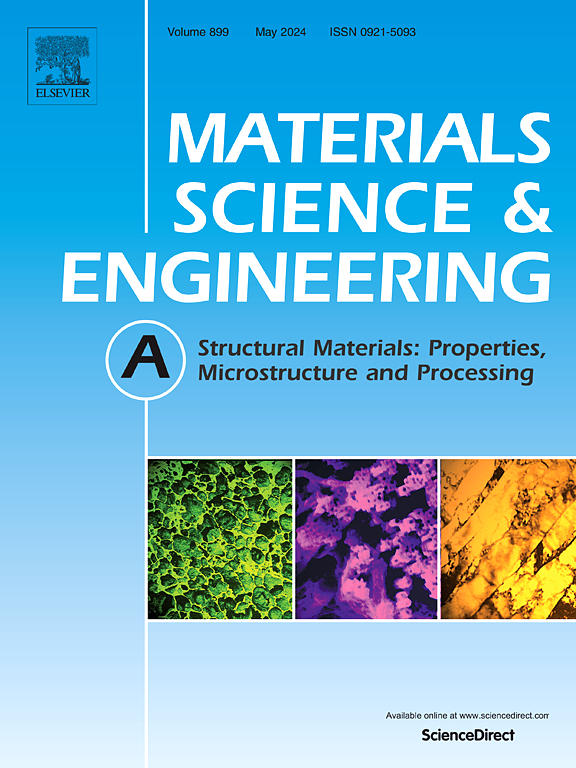Inconel 625增强CoCrFeMnNi高熵合金接头组织演变及局部强化机制
IF 6.1
2区 材料科学
Q1 MATERIALS SCIENCE, MULTIDISCIPLINARY
引用次数: 0
摘要
在基于熔焊的焊接工艺中,通常使用填充材料来调整和改善熔合区的组成,以优化组织和力学性能。然而,在高熵合金焊接领域,由于这些新型、先进的工程合金的焊接技术尚处于起步阶段,不同填充材料对其微观组织和力学响应的影响仍然很少。为了弥补这一知识差距,在著名的CoCrFeMnNi高熵合金的气体电弧焊中使用了Inconel 625填充丝。为了系统地分析焊接接头的组织演变和力学性能,采用了多尺度表征技术。结果表明,由于焊缝热循环的影响,焊接接头的不同区域具有不同的显微组织特征,而在熔合区,由于填充材料的引入,这些组织特征进一步加剧。Inconel 625填料的使用促进了熔合区的固溶强化效果,并成为该区域屈服强度的主要贡献者(302 MPa(通过固溶强化)vs 478 MPa(拉伸实验的屈服应力)。由于Hall-Petch强化在基材和热影响区都占主导地位,但由于形成了大晶粒结构,在熔合区不占主导地位,因此添加Inconel 625填料是提高典型的低熔合区强度的可行方法。通过将显微组织表征与力学性能分析相结合,在强化机理计算的辅助下,揭示了高熵合金气体保护焊的工艺、组织、性能关系,为高熵合金气体保护焊的广泛应用提供了更广泛的基础。本文章由计算机程序翻译,如有差异,请以英文原文为准。

Microstructure evolution and local strengthening mechanisms in CoCrFeMnNi high entropy alloy joints reinforced with Inconel 625
In the fusion-based welding processes, filler materials are commonly used to adjust and improve the composition of the fusion zone with the aim of optimizing both microstructure and mechanical properties. However, in the field of welding high entropy alloys, the influence of different filler materials on the microstructure and mechanical response is still scarce, owing to the yet incipient usage of welding technologies for these novel, advanced engineering alloys. To bridge this knowledge gap, Inconel 625 filler wire was used during gas metal arc welding of the well-known CoCrFeMnNi high entropy alloy. To systematically analyze the microstructure evolution and mechanical properties of the welded joints, multiscale characterization techniques were employed. It is shown that the different regions of the welded joint possess distinct microstructural features due to the weld thermal cycle, which is further compounded in the fusion zone by the introduction of the filler material. The use of Inconel 625 filler promotes a solid solution strengthening effect in the fusion zone and became the main contributor to the yield strength of this region (302 MPa (via solid solution strengthening) vs 478 MPa (yield stress from tensile experiments). Since Hall-Petch strengthening is predominant in both base material and heat affected zone, but not on the fusion zone due to the large grain structure that developed, the addition of Inconel 625 filler demonstrates to be a feasible approach to increase the typically low fusion zone strength. By coupling microstructural characterization with mechanical property analysis, aided by the calculation of the strengthening mechanisms, we unveil processing, microstructure, property relationships, providing a broader basis for the widespread application of gas metal arc welding for high entropy alloys.
求助全文
通过发布文献求助,成功后即可免费获取论文全文。
去求助
来源期刊

Materials Science and Engineering: A
工程技术-材料科学:综合
CiteScore
11.50
自引率
15.60%
发文量
1811
审稿时长
31 days
期刊介绍:
Materials Science and Engineering A provides an international medium for the publication of theoretical and experimental studies related to the load-bearing capacity of materials as influenced by their basic properties, processing history, microstructure and operating environment. Appropriate submissions to Materials Science and Engineering A should include scientific and/or engineering factors which affect the microstructure - strength relationships of materials and report the changes to mechanical behavior.
 求助内容:
求助内容: 应助结果提醒方式:
应助结果提醒方式:


